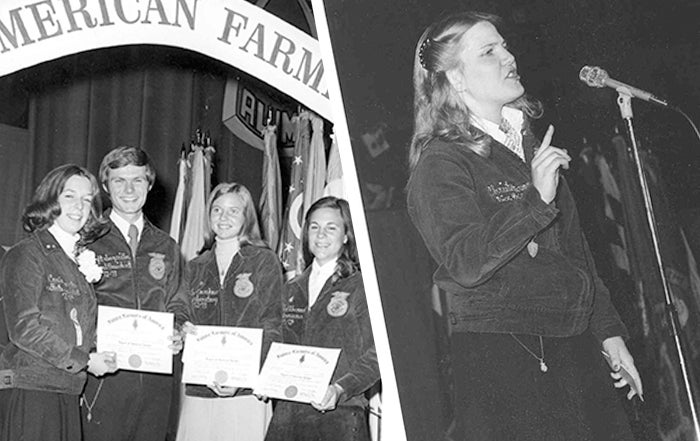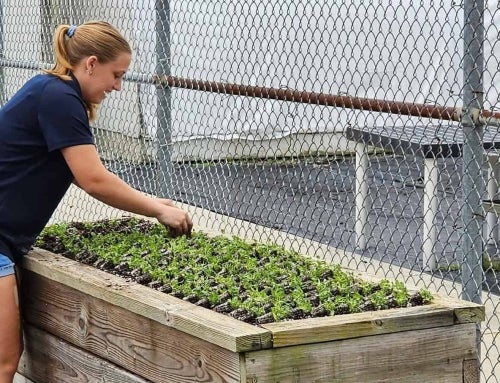It’s been 50 years since the 1969 National FFA Convention when women gained full membership. Let’s celebrate the decades of courage, diligence and relentlessness that paved the way.
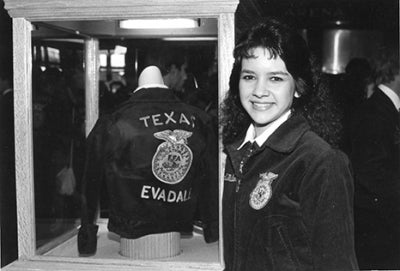
Evadale, Texas, member Chrystal McDaniel poses with the 3 millionth FFA jacket.
In 1942, D. Gilson was a successful member of the Port Royal FFA Chapter in Pennsylvania by every definition. Gilson was an engaged agricultural education student, led successful projects on the family farm, and received the chapter’s coveted Carpentry Award as a senior.
When the United States entered World War II, Gilson temporarily left college and worked as a welder, using the skills developed growing up on a farm and in agricultural mechanics classes in high school. After the war, Gilson completed college and went on to become a teacher and farmer. Unfortunately, you won’t find the successes and stories of Dorothy Gilson-Baker (D. Gilson), or thousands of other women like her, among any national archives. It wasn’t until 1969 that women were officially allowed membership into the National FFA Organization. However, in the 50 years since the formal acceptance of female membership, women have become an integral part of the organization. Women have achieved significant milestones, and they continue to shape the future of agricultural education and the industry of agriculture.
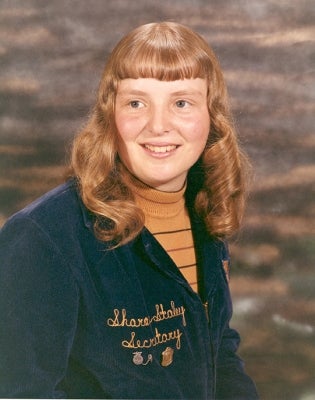
Sharon Staley of the White River FFA Chapter in Washington, models the first official girl’s FFA jacket.
The push for female membership wasn’t an effort led during a single business session of a single National FFA Convention. Rather, it was a feat that required incredible energy and efforts that began more than 30 years earlier. In the morning session of convention on Oct. 23, 1935, a Massachusetts delegate, Alfred Vaughan, was the first official member to broach the subject that women be allowed full membership at the national level. However, the question of female membership during this convention was resolved as follows:
“That when officially found that any State Association in a Future Farmers of America has girl members on its rolls, such State Associations shall be denied participation in all national Future Farmer of America contests and national F.F.A. awards. And no funds from the national treasury shall be available to such State Associations for the purpose of transporting delegates to the national conventions until such time as the names of the girl members are removed from the official rolls of the State Association and local chapters in accordance with the constitution.”
— Eighth National Convention Proceedings Report
For the next 30 years, state and local chapters integrated female membership at varying levels. Some females enrolled in agricultural education classes but were not allowed to become FFA members. Some women were added to rosters using initials that didn’t reveal their gender, like Dorothy Gilson-Baker. And other females were identified as “social ambassadors” for the chapter and received the coveted Sweetheart jacket.
If at First You Don’t Succeed …
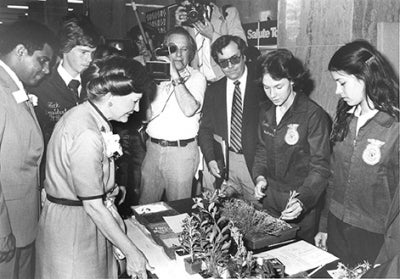
Women members participate in a horticulture demonstration in 1980.
The issue received little attention until the 1964 National FFA Convention. During the 37th convention, Paul Miller from Connecticut proposed an amendment to open national membership to women. Despite Miller moving to accept the amendment and a second by Irving Torres of Puerto Rico, the motion was defeated once again. Despite the amendment’s initial defeat, the delegates succeeded in bringing the topic back into the spotlight.
In January of 1966, an Ad Hoc FFA Organization Study Committee was formed to review various impacts of membership. The following August, the National FFA Board of Directors proposed constitutional changes based on this committee’s work, including the recommendation to remove the word male from the constitution. During the morning and afternoon business sessions on Oct. 13, 1966, delegates took part in intense debate and discussion on multiple sections of the ad hoc report. By the end of the convention, the delegates accepted all recommendations of the committee except for two, one of which was to drop the word male from the constitution.
Changing Times, But No Changes
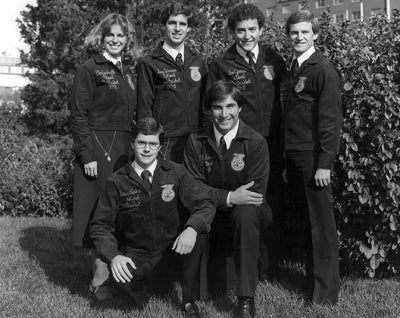
The 1979-80 national officers included Elin Duckworth of Arizona (back row, left).
During this time, the Vietnam War continued to rage overseas, Apollo 4 launched into space and Twiggy made her fashion debut. The climate and culture toward women’s rights throughout America continued to shift, as well, and in 1967, the Affirmative Action Policy was expanded to cover discrimination based on gender.
As political and legal environments adapted and changed, the National FFA Organization sought legal counsel for the obligation to accept females as members on the national level. Despite receiving legal interpretation that declared excluding females from membership was discriminatory, amendments could not be made to the constitution that year. Instead, the delegates of the 40th National FFA Convention were informed of the legal ruling concerning female members, instructed to take the information back to the local level, explore the situation and return to Kansas City in one year with the views of the members in order to provide appropriate discussion.
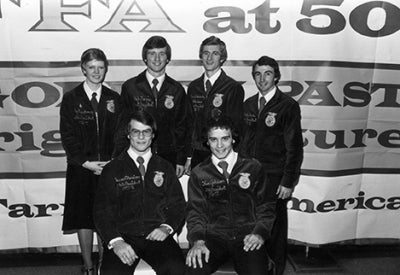
The 1977-78 national officers included Peg Armstrong of Iowa (back row, left).
At that time, approximately 3,300 females were enrolled in vocational agricultural classes nationwide and an increasing number of states accepted women as members. By many accounts, acceptance of female members was inevitable during the following convention.
On Oct. 17, 1968, Donald Shinn from New Jersey declared on the business floor, “Any student who is regularly enrolled in vocational agriculture is entitled to become an active member of any chartered FFA chapter.” The motion was quickly seconded by Richard Posthumus from Michigan, yet only a smattering of applause followed. The motion was defeated.
Yet, the spirit of the motion was not to be ignored. Howard Schrinar from Wyoming immediately stood before the delegate body and moved that each state appoint a committee to explore membership for women. Massachusetts once again made its stance known with a second from Donald Bridges. But again, the motion was defeated.
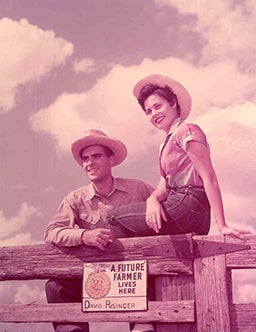
Prior to full membership, women were selected as “Chapter Sweehearts.” Here are Texas FFA sweetheart Martha Banks and Texas FFA president David Risinger in 1954.
Breaking Ground in 1969
Finally, one year later, on Oct. 15, 1969, Paul Bankhead of California moved and Robert Craig of Michigan seconded once more to strike the word male from the constitution. The motion carried.
On the morning of Oct. 17, Johnny Holland from Tennessee stood before the delegation and read the following resolution:
“WHEREAS, we, the delegates, to the Forty-Second annual convention have voted to allow all students of ocational agriculture to become members of the FFA;
“WHEREAS, we therefore have expressed our belief that all individuals are created equal and should have equal opportunities;
“WHEREAS, we also feel that only those who have competed on an equal basis and earned national recognition should be highly honored at our national convention; be it therefore
“RESOLVED, that we, the delegates, gathered here today, feel that the introduction of the first active female members to participate in the national FFA activities and the atmosphere and publicity thus associated with these events, be recognized as over-dramatized presentations and should not be taken as precedence set for following female participation, that instead FFA members, girls and boys, should be treated and honored equally.”
John Comegys from Delaware seconded the adoption of the resolution. The motion carried by a two-vote margin.
More than 12,000 days had passed since the initial idea was brought before the organization to the final acceptance of female FFA members.
The Aftermath
Since 1969, women have served as convention delegates, national officers and even been named as the American Star Farmer. Nearly half of all FFA members are women, and females hold approximately 50 percent of state leadership positions. In fact, if you peek into the archives once more, you might find a familiar name. Dorothy Gilson-Baker’s legacy continues through her granddaughter Libby Baker-Mikesell, the 2016-17 Pennsylvania state president.
The Female FFA Pioneers
It was 1969 that marked the first official year for female membership into the National FFA Organization. However, the following 50 years truly revealed just how much of an impact women could have in the organization. While names like Alfred Vaughan, Paul Miller and Donald Shinn are remembered for their contribution toward achieving female membership, there are countless other names today that inspire women who wear the blue jacket. Some of those names include:
Anita Decker and Patricia Krowicki
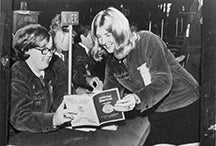
Just one year after female membership was secured, Anita Decker from New York and Patricia Krowicki from New Jersey served as the first female delegates at the 43rd National FFA Convention.
Julie Smiley
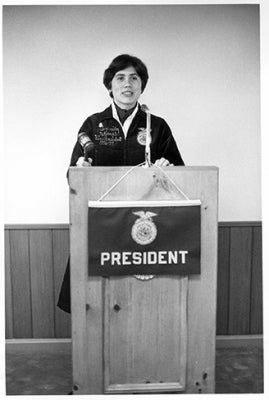
In 1976, Julie Smiley from Washington became the first woman to serve at the national level as the western region vice president. Since then, more than 80 women have been elected to the National FFA Officer Team.
Karlene Lindow
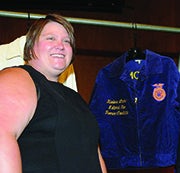
Karlene Lindow shattered another glass ceiling for women in FFA in 2002 when she was named the American Star Farmer. She raised hogs in Chili, Wis., and her jacket now hangs in the Smithsonian National Museum of American History.
Jan Eberly
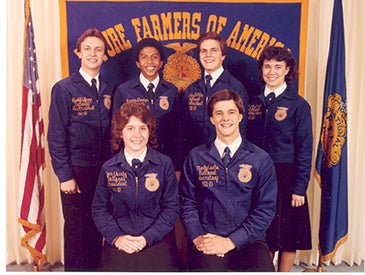
In 1982, Jan Eberly (seated lower left) from California was elected to serve as the first female national FFA president.

